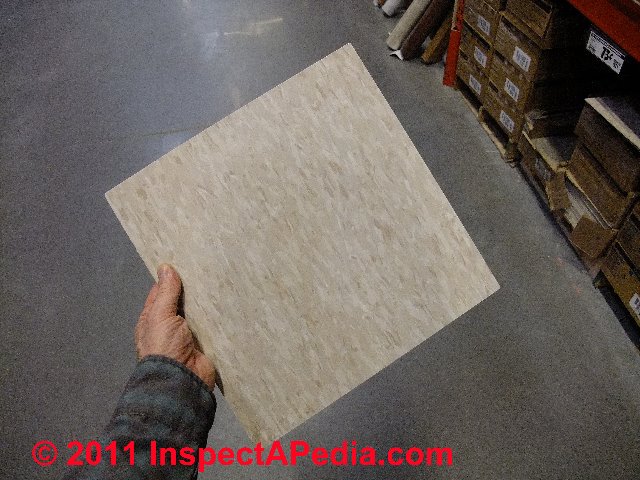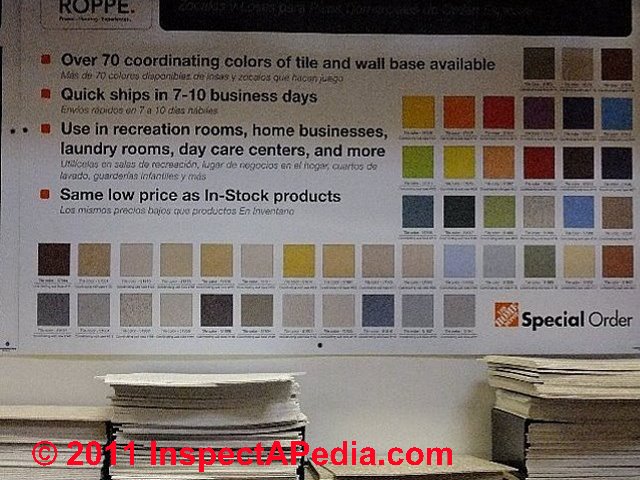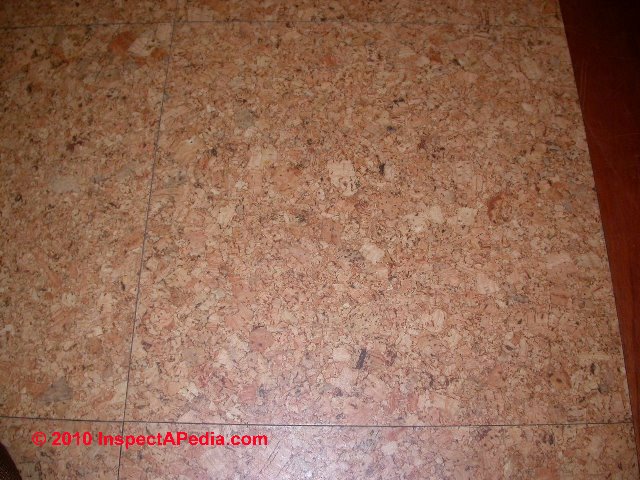 Resilient Flooring - Sheet Flooring Guide
Resilient Flooring - Sheet Flooring Guide
Best Practices Guide to Installing Resilient Flooring: Vinyl Tile, Sheet Vinyl, & Cork Floors
- POST a QUESTION or COMMENT about how to buy, inspect, troubleshoot, repair resilient flooring
This article explains the best practices used to install vinyl tile, sheet vinyl, cork floors, and other resilient flooring including modern linoleum.
This article series discusses and provides a best construction practices guide to the selection and installation of building interior surface materials, carpeting, doors, drywall, trim, flooring, lighting, plaster, materials, finishes, and sound control materials.
Also see INTERIORS of buildings, our home page for information about all topics relating to building interiors.
InspectAPedia tolerates no conflicts of interest. We have no relationship with advertisers, products, or services discussed at this website.
- Daniel Friedman, Publisher/Editor/Author - See WHO ARE WE?
Resilient Flooring: Selection & Installation Guide to Sheet Vinyl & Vinyl Tile Floors
 As described in the book, Best Practices Guide to Residential Construction (Steve Bliss, J Wiley & Sons) Chapter 5, Interior Finish:
As described in the book, Best Practices Guide to Residential Construction (Steve Bliss, J Wiley & Sons) Chapter 5, Interior Finish:
Multi layer sheet vinyl is by far the most common material used in resilient floors.
It comes in a variety of grades and a vast array of colors and patterns and, if installed well and maintained properly, should last 10 to 20 years.
Solid vinyl tiles are another popular option; but, with multiple seams, they are more vulnerable to intrusions from water and dirt. Natural alternatives to vinyl that are growing in popularity include cork, in sheet or tile form, and old-fashioned linoleum, which is making a comeback in residential installations with new colors and marbleized patterns.
Sheet Vinyl Floor Properties & Installation Guide
Sheet vinyl is manufactured to be either fully adhered to the substrate with mastic or bonded only at the edges, called a perimeter-bond system.
Flex-type vinyl flooring, made for perimeter-bond installation, tolerates minor unevenness and movement in the substrate better than fully adhered systems, but fully adhered systems are more durable overall and less likely to be damaged from stresses like a heavy piece of furniture being dragged across.
All modern sheet vinyl flooring has three layers:
- Backing layer.
Typically, this is felt or vinyl. Better grades generally have vinyl backing that resists denting better than felt. To improve the tear resistance and toughness of layered flooring, some manufacturers laminate an additional layer between the core layer and the backing. - Core layer.
This is a foam interlayer that gives the material its resilience and resistance to denting.
The color and pattern are either printed on this layer or “inlaid.” With inlaid construction, the color and pattern run through the material from the wear layer to backing, making it less prone to show a small nick in the surface. - Wear layer.
The top layer protects the flooring from wear and is generally either clear vinyl or a more durable urethane (PUR) finish, sometimes enhanced with aluminum oxide or other additives to increase wear resistance.
Many finishes are marketed as “nowax,” but these are not maintenance-free and require periodic application of an acrylic dressing. Lower gloss finishes are recommended for high-traffic areas.
Better quality vinyl floors tend to be thicker overall and have a thicker and higher-quality wear layer. As the wear layer gets abraded from dirt and grime, it becomes duller and harder to clean.
The thickness of the wear layer can range from 5 to 25 mils, and the flooring thickness from about 1/16-inch to 1/8-inch.
Better quality products offer better resistance to stains and scratches than lower-end floors, and some of the top quality floors are guaranteed not to rip or permanently dent.
How to Select & Install Solid Vinyl Floor Tiles: Solid Vinyl, VAT, VCT
Vinyl Flooring Products 1900 - 1986 May Contain Asbestos

Similar to inlaid sheet vinyl, the color and pattern in solid vinyl tiles run through the full thickness of the tile, making them very durable. Because the color and pattern extend through the tile, they do not wear away with heavy use, but choices are limited.
Our photo (left) shows cork-pattern solid vinyl floor tiles from the 1960's.
Typically vinyl floor tiles, or VAT (vinyl-asbestos tile) from this era contain asbestos, and special procedures are required if the floor is to be demolished.
See ASBESTOS FLOORING IDENTIFICATION
and
if your building contains these products, see
also ASBESTOS FLOORING HAZARD REDUCTION
Modern solid vinyl tiles are cut from a solid block of material and come with a low-gloss finish.
One type, vinyl composition tile or VCT, is essentially the same product as solid vinyl, but with other binders and fillers. Both types require waxing and buffing, both to seal any gaps between tiles and to create an easy-to-clean surface.
As we detail at ASBESTOS FLOOR TILE IDENTIFICATION PHOTOS 1949-1959, depending on the age of manufacture, some resilient flooring products used asbestos as a primary ingredient.
Contemporary resilient flooring products such as the vinyl floor tile shown at left do not contain asbestos however.
At left is a photo of Armstrong Excelon Vinyl Floor tile, a contemporary , popular resilient floor covering, sold in 70 colors at retail outlets including Home Depot stores, this modern resilient floor tile does not contain asbestos. [Click any image to see an enlarged, detailed version]
A catalog of floor tile identification photographs for products that contained asbestos, 1952 - 1980, is provided below at Armstrong Vinyl-Asbestos Floor Tile Photo ID Catalog - 1952 - 1986.
And at Armstrong flooring history we provide a history of Armstrong flooring and links to company information.
Below our photo shows a color chart for contemporary Armstrong vinyl floor tiles.
Vinyl Floor Tile Installation Procedure
Vinyl flooring can be installed over approved wood-based underlayments, dry concrete, or existing vinyl or linoleum if it is in good condition, clean, and free of wax or grease.
However, any imperfection in the underlayment will telegraph through the finished floor, so if there are any questions, it is best to install new underlayment.
Most problems with vinyl are caused by problems with the underlayment, such as nail pops and swelling or delamination due to moisture.
Adhesive failures at edges or seams can also be a problem.
To avoid these types of problems, use only underlayments and adhesives that are recommended by the flooring manufacturer.
Also, if possible, avoid seams—most sheet vinyl comes in 6- and 12-foot rolls, so many rooms can be done without a seam. If seams are required, darker colors and textured pattern are preferable and help hide dirt and scuff marks as well.
All seams should be sealed with an approved sealer to keep dirt out and to keep water from penetrating and undermining the adhesive bond.
Guide to Installing Vinyl Floor Tiles over Concrete
If installing over a concrete slab, make sure it has a proper vapor barrier and has cured for at least 60 days. A concrete sealer is recommended. Existing slabs should be wire brushed, swept clean, and primed with an approved primer before gluing down resilient flooring.
Acclimatization Requirements for Vinyl Tile Floors
Because vinyl shrinks and expands with room temperature, it should be allowed to adjust to the room temperature before installation. In general, the room should be heated or cooled to its normal temperature and the vinyl allowed to acclimate for 24 hours.
Underlayments for Vinyl Floor Tile Systems
For a problem-free floor, sheet vinyl must be installed over a smooth, hard, and dry surface approved for use with vinyl.
- See FLOOR TILE BASE LEVELING if you are installing new vinyl tiles or sheet flooring over an irregular surface or over an old floor where some tiles have been removed.
- Plywood underlayment for floor tiles: The most reliable underlayment, accepted by
all vinyl flooring manufacturers, is sanded plywood
with solid inner plies (no voids) that resist denting or
puncturing.
This is usually either designated “Underlayment with sanded face” or “C-C Plugged with sanded face.” (Other possible grades include “Plugged crossbands under face” or “Plugged inner plies”). Avoid plywood with plastic or resin fillers on the surface, as these may stain the vinyl. - Lauan (luan) underlayment for floor tiles. Type 1 exterior-grade luan plywood is sometimes
used as an underlayment and is approved by
some vinyl flooring manufacturers.
If using luan, use the best grade available, which is often labeled B-B.
Note: Luan, plywood spelled in some texts as Lauan, plywood is the same material as Philippine Mahogany, wiggle wood, wacky wood, bendy wood, snakewood, and meranti. Merriam Webster defines lauan as
the light yellow to reddish-brown or brown wood of any of various tropical southeast Asian trees (as of the genera Shorea and Parashorea) which sometimes enters commerce as Philippine mahogany - Particleboard underlayment for floor tiles. This is discouraged by most manufacturers
but is sometimes used in areas with limited
exposure to moisture, since particleboard has the
potential to swell at edges if wet.
Also, the particleboard surface can tear when installers pull back the vinyl to spread adhesive at seams.
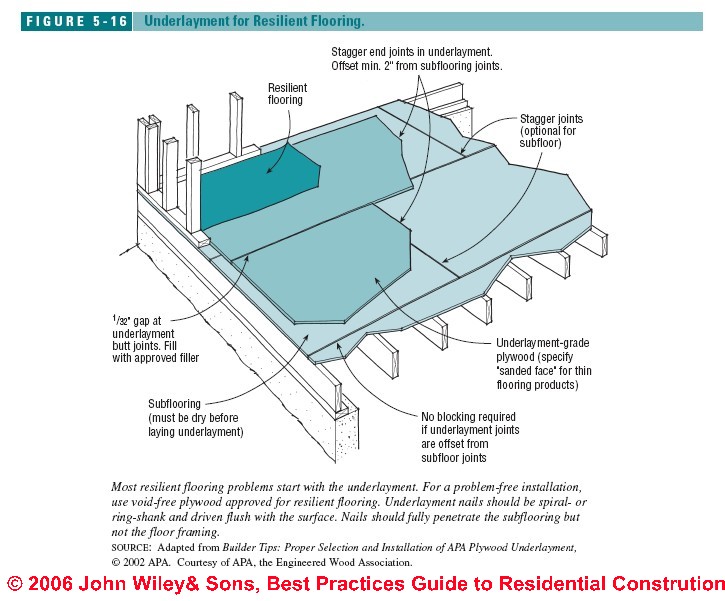
Make sure the subflooring is dry before installing the underlayment.
Use minimum1/4-inch-thick panels so that the underlayment plus subfloor is at least 1 inch thick.
Stagger joints in the underlayment so they are offset from joints in the floor sheathing by at least 2 inches (see Figure 5-16).
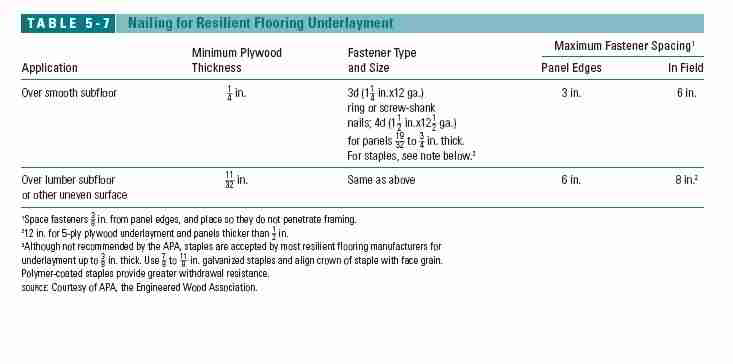 Most flooring manufacturers specify a 3 1/2-inch gap
between sheets, filled with a quick-setting latex-based
cementious filler. The filler restrains the edges of the
underlayment and helps prevent ridging from movement
or the absorption of flooring adhesive at panel edges.
Most flooring manufacturers specify a 3 1/2-inch gap
between sheets, filled with a quick-setting latex-based
cementious filler. The filler restrains the edges of the
underlayment and helps prevent ridging from movement
or the absorption of flooring adhesive at panel edges.
The nailing schedule for resilient flooring underlayment is shown in Table 5-7 .
[Click to enlarge any table or image]
Fasteners should approximately equal the thickness of the underlayment and subfloor and should not be driven into the framing.
Many contractors prefer staples to nails, because they do not leave dimples in the underlayment. Before using staples, however, make sure that they are approved by the resilient-flooring manufacturer.
Nails should be ring-shank or spiral-shank and driven flush or just below the surface, but the heads should not be filled.
Other holes, gaps, and voids should be filled with a latex-based cementious filling compound before laying the floor.
Natural Alternatives to Vinyl Floors: Cork Floors
Homeowners who want a resilient floor covering but are looking for an alternative to vinyl should consider the new cork products as well as traditional linoleum, which is enjoying a comeback in residential applications.
Cork has a number of desirable attributes for a flooring material: its air-filled, watertight cells are strong, soft to walk on, and insulating, making it a good choice over a concrete slab.
To make it into flooring, manufacturers grind up the cork, mix it with a chemical binder, bake the material, and slice it into sheets. Cork flooring products range in thickness from 3/16 to 7/16- inch for some laminated products.
Details about cork flooring are at CORK FLOORING
Most cork flooring is sold as tiles and installed with adhesive, similarly to other resilient tiles. Tiles are available either unfinished or pre-finished with carnauba wax or a more durable polyurethane or acrylic coating.
Tiles tend to have natural color variation and can be purchased in light, medium, or dark tones.
Guide to Modern Linoleum Floors
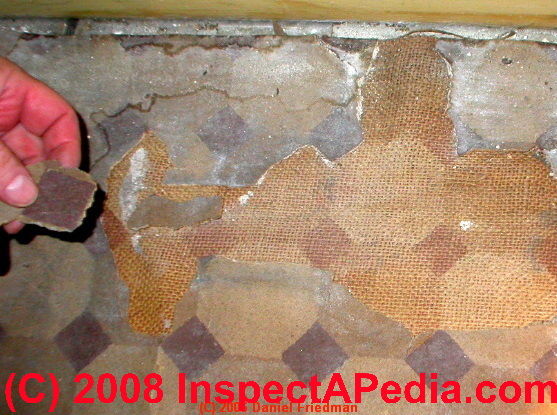 For the last 50 years or so, linoleum has
been used almost exclusively in commercial settings, but
it is making a comeback in residential settings, due largely
to its use of all-natural ingredients and reputation for durability.
For the last 50 years or so, linoleum has
been used almost exclusively in commercial settings, but
it is making a comeback in residential settings, due largely
to its use of all-natural ingredients and reputation for durability.
Our photo (left) shows antique sheet flooring found in a home built in the 1800's.
Details about linoleum flooring are
Linoleum is made by boiling oil to form a thick cement paste that is mixed with pine rosin, wood flour, and other fillers such as clay or limestone to make a durable, resilient sheet flooring that wears well and resists indentation.
The backing is typically jute fabric, a natural fiber. Other than relatively minor initial off-gassing from the linseed oil base, linoleum is considered nontoxic by most healthy-house advocates.
It is also naturally antimicrobial and anti static, making it well suited for hospitals, schools, and rooms with electronic equipment. If well maintained, a linoleum floor can provide a 20- to 30-year service life.
In response to new demand for the product in recent years, manufacturers have responded with a wide variety of solid and marbleized colors and attractive checkered patterns, available in sheet form as well as 19x19-inch tiles that can be mixed to create borders and other designs.
Unlike vinyl, linoleum colors go all the way through the product, making scratches and wear spots less noticeable than on vinyl. Also, scratches, cigarette burns, and other surface wear can be removed with steel wool or a nylon abrasive pad and buffed out.
However, since linoleum does not have a separate wear layer like vinyl flooring and is slightly porous, it requires somewhat more maintenance than vinyl. Applying a sealer or polish to the new floor will help it resist stains and make it easier to clean.
Also, portions of a linoleum floor not exposed to light will tend to darken or yellow due to the natural oxidation of the linseed oil base. This coloration will disappear upon exposure to light, and the original linoleum color will be restored, or “bloom.”
All linoleum flooring is now manufactured in Europe. The largest supplier in the United States is European-based Forbo Linoleum, Inc., but U.S.-based flooring companies such as Armstrong are beginning to offer linoleum products as well. A unique floating linoleum plank floor that can be installed with or without glue is available from Nova Distinctive Floors.
- - Adapted with permission from Best Practices Guide to Residential Construction (Steve Bliss, J Wiley & Sons) .
Resilient Flooring Manufacturers List
- Congoleum www.congoleum.com Vinyl sheet flooring and tiles
- Domco (division of Domco Tarkett Group) www.domco.com Vinyl sheet flooring and tiles
- Forbo www.forbo-flooring.com Linoleum sheet and tiles
- Mannington Mills www.mannington.com Vinyl sheet flooring and tiles
- Nova Distinctive Floors www.novafloorings.com Laminated linoleum surface over fiberboard and cork planks, floating installation
- Tarkett www.tarkettna.com Vinyl sheet flooring and tiles
Cork Flooring Manufacturers & Sources
- American Cork Products Co. www.amcork.com Prefinished parquet tiles and floating floor planks
- Amorim Revestimentos (formerly Ipocork) www.wicanders.com Floating or glue-down laminated cork tiles with UV-acrylic or oil finish
- BHK of America www.bhkuniclic.com Snap-together, no-glue, laminated cork flooring with UV-acrylic finish
- Expanko Cork Inc. www.expanko.com Cork tiles with wax or polyurethane finish
- Korq Inc. (212) 758-2593
- Natural Cork www.naturalcork.com Glue-down cork tiles and floating laminated planks with UV-cured acrylic finish
- Nova Distinctive Floors www.novafloorings.com Laminated cork planks with glue-down and floating click-lock installation
- WECork www.wecork.com Cork tiles, sheets, and floating floors
Industry & Trade Associations for Flooring Products
- American Lighting Association www.americanlightingassoc.com
- Association of the Wall and Ceiling Industries www.awci.org
- Carpet and Rug Institute (CRI) www.carpet-rug.org
- Drywall Finishing Council www.dwfc.org
- Forest Stewardship Program www.fscus.org
- FloorFacts www.floorfacts.com
- The Gypsum Association www.gypsum.org
- National Oak Flooring Manufacturers Association (NOFMA) www.nofma.com
- National Wood Flooring Association www.woodfloors.org
- Painting and Decorating Contractors of America www.pdca.org Smartwood/Rainforest Alliance www.smartwood.org
- - Adapted with permission from Best Practices Guide to Residential Construction (Steve Bliss, J Wiley & Sons) .
...
Reader Comments, Questions & Answers About The Article Above
Below you will find questions and answers previously posted on this page at its page bottom reader comment box.
Reader Q&A - also see RECOMMENDED ARTICLES & FAQs
Question: How Should I Handle Exposed Sheet Flooring Underside I can See in My Duct System?
I have these pictures of the flooring surrounding the floor air vent in the bathroom of my house. Both are taken from inside the vent looking up. The white overhang is the bottom of the relatively new sheet flooring which is placed over the 1978 bathroom floor which is most likely some sort of sheet vinyl/linoleum . It's a typical bathroom floor.
Between the wood floorboard and the white overhang (new floor), you can see a brown looking material. I'm not sure if this is backing of the original floor, backing of the new floor, or something else entirely.
Without speculating too much, was the asbestos paper backing used on old flooring typically white in color? I'd like to rid the idea that the brown part you see (although blurry) is an asbestos backing. if realistic. I understand testing is the only way but im not about to rip it out.
Thanks for your time and I enjoy your website. it's very informative. I refer many people to it. - J.L.
Reply: Yes old sheet flooring asbestos backing is typically white, but it could be a different color by now - here's what we'd do:
I am sorry to say that the photos were too blurry for me to have much of an opinion - I know how tough it is to get the camera to focus in those odd awkward places. That said, here are some things to consider:
In my (limited) experience with asbestos-containing backing on sheet flooring, yes it's usually quite light or white in color.
But of course if it was exposed to dirt, dust, debris, spills, its color may be changed from original. If you think the flooring you see was installed before 1986 it's reasonable to presume it contains asbestos and to treat it accordingly - meaning don't make a mess.
It sounds as if it's all covered with other layers so it surely isn't much of a fiber release hazard in your home in general.
But I agree that if asbestos-suspect material is exposed in the air path of your HVAC system ductwork, it would be prudent to see if you could cover or encapsulate it - probably you'd use a spray on coating if you can't reach the exposed surface to laminate something over it.
That'd be much less disturbance than tearing up floors unnecessarily. - DF
How to Level Up Resilient Tile Floor Surfaces
This discussion has moved to FLOOR TILE BASE LEVELING
...
Continue reading at CORK FLOORING or select a topic from the closely-related articles below, or see the complete ARTICLE INDEX.
Or see these
Related Articles
- ASBESTOS FLOORING HAZARD REDUCTION - home
- ASBESTOS FLOORING LEFT IN PLACE - using sealants
- FLOOR TILE BASE LEVELING - smooth out irregularities before putting down new tile or resilient sheet flooring
- FLOOR TYPES & DEFECTS
- FLOORING ADHESIVE MASTIC SEALANTS
- LINOLEUM & SHEET FLOORING
- POURED-IN-PLACE FLOORING, RESILIENT - pour on a whole new floor surface
Suggested citation for this web page
RESILIENT FLOORING VINYL or CORK at InspectApedia.com - online encyclopedia of building & environmental inspection, testing, diagnosis, repair, & problem prevention advice.
Or see this
INDEX to RELATED ARTICLES: ARTICLE INDEX to BUILDING FLOORING
Or use the SEARCH BOX found below to Ask a Question or Search InspectApedia
Ask a Question or Search InspectApedia
Try the search box just below, or if you prefer, post a question or comment in the Comments box below and we will respond promptly.
Search the InspectApedia website
Note: appearance of your Comment below may be delayed: if your comment contains an image, photograph, web link, or text that looks to the software as if it might be a web link, your posting will appear after it has been approved by a moderator. Apologies for the delay.
Only one image can be added per comment but you can post as many comments, and therefore images, as you like.
You will not receive a notification when a response to your question has been posted.
Please bookmark this page to make it easy for you to check back for our response.
IF above you see "Comment Form is loading comments..." then COMMENT BOX - countable.ca / bawkbox.com IS NOT WORKING.
In any case you are welcome to send an email directly to us at InspectApedia.com at editor@inspectApedia.com
We'll reply to you directly. Please help us help you by noting, in your email, the URL of the InspectApedia page where you wanted to comment.
Citations & References
In addition to any citations in the article above, a full list is available on request.
- Steve Bliss's Building Advisor at buildingadvisor.com helps homeowners & contractors plan & complete successful building & remodeling projects: buying land, site work, building design, cost estimating, materials & components, & project management through complete construction. Email: info@buildingadvisor.com
Steven Bliss served as editorial director and co-publisher of The Journal of Light Construction for 16 years and previously as building technology editor for Progressive Builder and Solar Age magazines. He worked in the building trades as a carpenter and design/build contractor for more than ten years and holds a masters degree from the Harvard Graduate School of Education. Excerpts from his recent book, Best Practices Guide to Residential Construction, Wiley (November 18, 2005) ISBN-10: 0471648361, ISBN-13: 978-0471648369, appear throughout this website, with permission and courtesy of Wiley & Sons. Best Practices Guide is available from the publisher, J. Wiley & Sons, and also at Amazon.com - Our recommended books about building & mechanical systems design, inspection, problem diagnosis, and repair, and about indoor environment and IAQ testing, diagnosis, and cleanup are at the InspectAPedia Bookstore. Also see our Book Reviews - InspectAPedia.
- Pergo AB, division of Perstorp AB, is a Swedish manufacturer or modern laminate flooring products. Information about the U.S. company can be found at http://www.pergo.com where we obtained historical data used in our discussion of the age of flooring materials in buildings.
- In addition to citations & references found in this article, see the research citations given at the end of the related articles found at our suggested
CONTINUE READING or RECOMMENDED ARTICLES.
- Carson, Dunlop & Associates Ltd., 120 Carlton Street Suite 407, Toronto ON M5A 4K2. Tel: (416) 964-9415 1-800-268-7070 Email: info@carsondunlop.com. Alan Carson is a past president of ASHI, the American Society of Home Inspectors.
Thanks to Alan Carson and Bob Dunlop, for permission for InspectAPedia to use text excerpts from The HOME REFERENCE BOOK - the Encyclopedia of Homes and to use illustrations from The ILLUSTRATED HOME .
Carson Dunlop Associates provides extensive home inspection education and report writing material. In gratitude we provide links to tsome Carson Dunlop Associates products and services.


